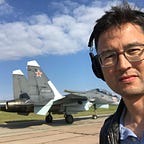Gateway to Nowhere
The traffic cop who stops us is surprisingly jovial. A “special operation” against terrorists is under way.
Russia’s oldest city is only Russian on a map. In every other respect – history, culture and ethnic makeup – it belongs to the greater Middle East.
Derbent, Russia’s southernmost city, sounds as unfamiliar and exotic to Russian ears as it does to foreigners’. One reason is that it became part of the Russian Empire just 200 years ago. Another reason is that it’s in Dagestan, an unruly province where the only Russians who dare to stick around are state security agents or ethnographers.
For 2,000 years, Derbent controlled the trade route connecting Persia to the steppes of the Volga Basin. Parallel walls extended from the mountainside citadel all the way down into the Caspian Sea, enclosing the town and shielding the civilizations to the south from the barbarians in the north. In Persian, darband means “closed gates.”
Photo: Lucian Kim
Like the Moscow Kremlin or central St. Petersburg, Derbent is a UNESCO World Heritage site. Yet Derbent’s dead-end location on the border with Azerbaijan means that nobody stops by to visit anymore.
It’s an easy two-hour drive from Makhachkala, down the Caspian coast through a plain lush with fields and vineyards – a contrast to the desolation I witnessed in the mountains. Arslan, the taciturn but able driver I met on my first day in Dagestan, agrees to take me.
As we enter Derbent, a fat traffic policeman stops our car, a black Lada of the make preferred by suicide bombers. The cop is surprisingly jovial, and after thumbing through my passport, wishes me well. He says that a “special operation” against terrorists is under way, but Arslan later explains that the police usually make that claim as a pretext for stopping people.
The city’s ancient walls and gates live up to my expectations, as I already have an impression of Derbent from the old prints I saw in the museum in Makhachkala.
Arslan and I begin our sightseeing at the fortress. The buildings are made of handsome, light stone, which reminds me of the shah’s palace in glittering Baku, another 200 kilometers down the coast.
Our guide is a young, articulate man named Marat. He tells us that Derbent was selected as the “most tolerant city” in 2006. A multitude of ethnic groups have called Derbent home over the centuries, yet after the collapse of the Soviet Union, the city’s Jews and Christians turned their back on the city.
Photo: Lucian Kim
Marat leads us around the fortress, reeling off facts and figures. Not only did the fortifications cascade down to the town below, he says, but they extended 50 kilometers into the mountainous hinterland.
I find the citadel in surprisingly good condition, with the walls restored and the grounds tidy. The last substantial renovation was in the 1970s, Marat says. Now most of the money allocated for improvements is stolen.
Marat shows us a prison, actually just a hole in the ground where criminals could contemplate their evil deeds. Traitors were lowered into another pit and left to rot. Even the citadel’s sentries didn’t have it easy. They were set out on a small platform jutting from the wall without any railings. If they were careless enough to doze off, they would plunge to their deaths.
I’m most intrigued by the remains of a Christian church dating back to the times of Caucasian Albania, long before Islam was even born. Over the centuries, the church has become almost entirely buried. Curved metal bars on ground level show the outline of the cupola.
We stare down 10 meters below us into the sanctuary of a church that was founded almost two millennia ago. The underground church was later used as a cistern. Vladimir Putin – who visited the fortress by helicopter in 2005, presumably out of security concerns – expressed an interest in restoring the church. In Dagestan, his wish is nobody’s command.
Derbent’s strategic value for most of its history is obvious. Marat says that the tolls extracted by the city’s customs office on Silk Road traders equaled half the total value of a caravan. Today Derbent doesn’t even have a working port.
Photo: Lucian Kim
Arslan and I descend from the airy heights of the fortress and take a walk through the old town, a warren of streets squeezed between the remains of the walls leading to the sea. We pass through an ancient gate guarded by a stylized, smiling cat with an enormous head.
Derbent feels more like Central Asia or the Middle East than Russia. Most of the houses are rundown, though I spot some that are freshly renovated, with new windows and plaster.
We make our way to the imposing Armenian church, built in the mid-19th century. It’s now used as a gallery for rugs and other handicrafts. The bullet marks that pock the outside walls are testament to the ethnic strife that caused the church to close. The remaining Armenian community uses the building on religious holidays, the ticket-seller tells us.
There’s nothing else to see or do in Derbent, and it’s better to be off the roads before dark. We return to the car.
I like Arslan’s discreet style. Unlike other drivers who pry or pontificate, he concentrates on the road. He doesn’t even ask where I come from.
On the drive back to Makhachkala, Arslan opens up. He wanted five children but his wife could only bear two because of health reasons. After spending his 47 years in Dagestan, he wishes he could visit a place like Egypt to expand his horizons.
“I’m a romantic,” Arslan declares. He’s not interested in dusty cities like Makhachkala or Derbent. He’d most like to live on the coast, or maybe in the woods.
Arslan pauses. On second thought, the boyeviki – Islamist fighters – have made that dream all but impossible.
